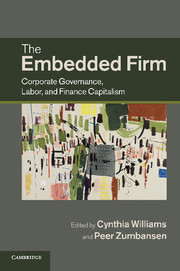Book contents
- Frontmatter
- Contents
- Figures
- Tables
- Contributors
- 1 Introduction: corporate governance after the ‘end of history’
- Part I Historical trajectories of business and regulation
- Part II New interests, new shareholder constellations, new landscapes
- Part III Labor’s evolution in the new economy
- 13 Labor and finance in the United States
- 14 The conflicting logic of markets and the management of production
- 15 Organizing workers globally
- 16 From governance to political economy
- Part IV The transnational embedded firm and the financial crisis
- Part V Conclusion
- Index
15 - Organizing workers globally
the need for public policy to regulate investment
from Part III - Labor’s evolution in the new economy
Published online by Cambridge University Press: 07 September 2011
- Frontmatter
- Contents
- Figures
- Tables
- Contributors
- 1 Introduction: corporate governance after the ‘end of history’
- Part I Historical trajectories of business and regulation
- Part II New interests, new shareholder constellations, new landscapes
- Part III Labor’s evolution in the new economy
- 13 Labor and finance in the United States
- 14 The conflicting logic of markets and the management of production
- 15 Organizing workers globally
- 16 From governance to political economy
- Part IV The transnational embedded firm and the financial crisis
- Part V Conclusion
- Index
Summary
Introduction
Organizing workers and collective bargaining are central activities of trade unions, but clearly they do not take place in a political or economic vacuum. With globalization, workers are increasingly part of global supply chains where companies can relocate investment to counter union pressure or undertake regulatory arbitrage. The thinking behind policy advocacy by unions covering the global economy is precisely to increase the leverage that unions have at all levels to organize workers, to negotiate with and have influence over multinational enterprises.
The financial crisis that deepened in September 2008 with the collapse of Lehman Brothers has mutated into a jobs crisis and sovereign debt crisis that has major social costs. However there was already a crisis of distributional justice, in part due to the impacts of market driven globalization before the onset of the financial crisis.
- Type
- Chapter
- Information
- The Embedded FirmCorporate Governance, Labor, and Finance Capitalism, pp. 333 - 349Publisher: Cambridge University PressPrint publication year: 2011

